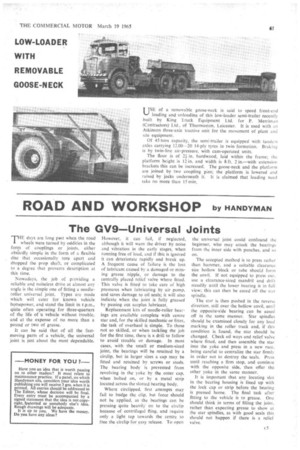ROAD AND WORKSHOP by HANDYMAN
Page 63

If you've noticed an error in this article please click here to report it so we can fix it.
The GV9 Universal Joints
THE days are long past when the road wheels were turned by oddities in the form of couplings or joints, either absurdly simple in the form of a flexible disc that occasionally tore apart and dropped the prop shaft, or complicated to a degree that prevents description at this time.
Nowadays, the job of providing a reliable and noiseless drive at almost any angle is the simple one of fitting a needleroller universal joint. Types are made which will cater for known vehicle horsepower, and stand the limit in r.p.m., quite often operating for three-quarters of the life of ta vehicle without trouble, and at the expense of no more than a pound or two of grease.
It can be said that of all the fastmoving parts of a vehicle, the universal joint is just about the most dependable. However, it can fail, if neglected, although it will warn the driver by noise and vibration in the early stages, when running free of load, and if this is ignored it can deteriorate rapidly and break up. A frequent cause of failure is the loss of lubricant caused by a damaged or missing grease nipple, or damage to the centrally placed relief valve where fitted. This valve is fitted to take care of high pressures when lubricating by air pump, and saves damage to oil seals; it will also indicate when the joint is fully greased by passing out surplus lubricant.
Replacement kits of needle-roller bearings are available complete with centre star and, for the skilled mechanic or fitter, the task of overhaul is simple. To those not so skilled, or when tackling the job for the first time, there is a drill to follow to avoid trouble or damage. In most cases, with the small or medium-sized joint, the bearings will he retained by a circlip, but in larger sizes a cap may be fitted and retained by screws or studs. The bearing body is prevented from revolving in the yoke by the outer cap, when bolted on, or by a metal strip located across the slotted bearing body.
Where circlipped. first attempts may fail to budge the clip, but force should not be applied, as the bearings can he pressing quite heavily on to the circlip because of centrifugal fling, and require only a light tap towards the centre to free the circlip for easy release. To open
the universal joint could confound the beginner, who may attack the bearings from the inner side with punches, and so on.
The accepted method is to press rather than hammer, and a suitable clearance size hollow block or tube should form the anvil. If not equipped to press out. use a clearance-sized mandril and drift steadily until the lower bearing is in full view; this can then be eased off the star spindle.
The star is then pushed in the reverse direction, still over the hollow anvil, until the opposite-side bearing can be eased off in the same manner. Star spindles should be examined closely for any load marking in the roller track and, if this condition is found, the star should be changed. Check oil ways and relief valve where fitted, and then assemble the star into the yoke and press in a new race. being careful to centralize the star firmly in order not to destroy the seals. Press until reaching a firm stop, and continue with the opposite side, then offer the other yoke in the same manner.
It is important that any locating slot in the bearing housing is lined up with the lock cap or strip before the bearing is pressed home. The final task after fitting to the vehicle is to grease. One should think in terms of filling the joint, rather than expecting grease to show at the star spindles, as with good seals this should not happen if there is a relief valve.












































































































































